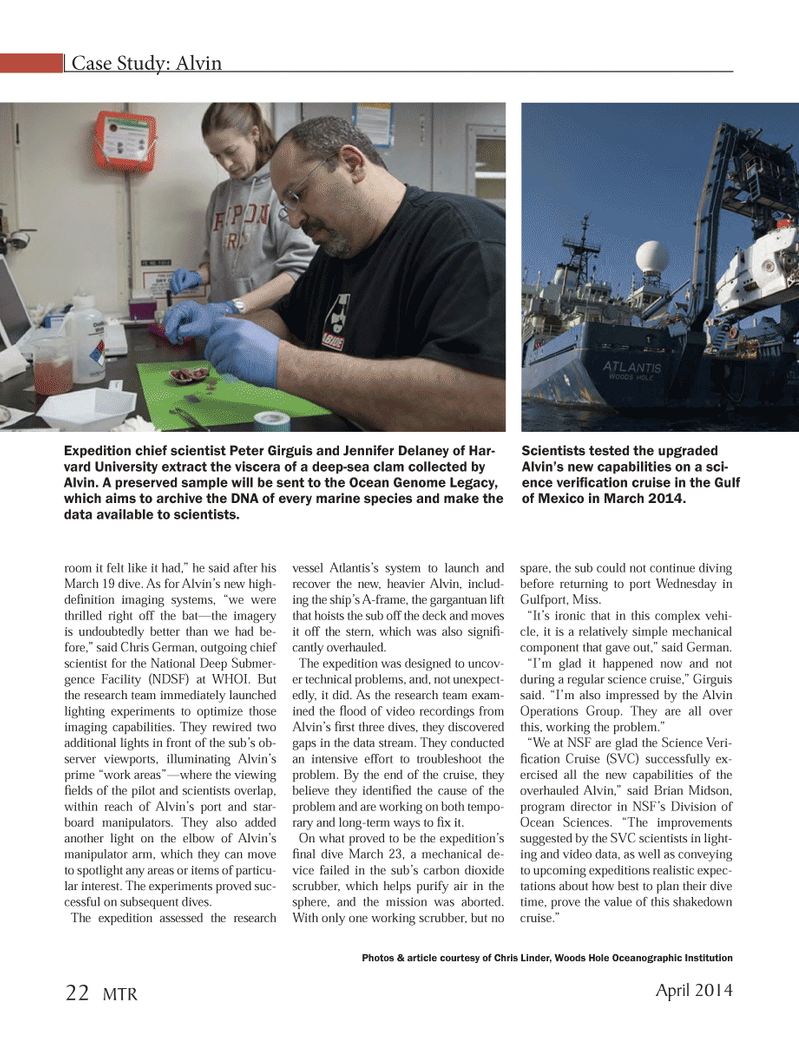
Page 22: of Marine Technology Magazine (April 2014)
Offshore Energy
Read this page in Pdf, Flash or Html5 edition of April 2014 Marine Technology Magazine
Case Study: Alvin room it felt like it had,” he said after his
March 19 dive. As for Alvin’s new high- defi nition imaging systems, “we were thrilled right off the bat—the imagery is undoubtedly better than we had be- fore,” said Chris German, outgoing chief scientist for the National Deep Submer- gence Facility (NDSF) at WHOI. But the research team immediately launched lighting experiments to optimize those imaging capabilities. They rewired two additional lights in front of the sub’s ob- server viewports, illuminating Alvin’s prime “work areas”—where the viewing fi elds of the pilot and scientists overlap, within reach of Alvin’s port and star- board manipulators. They also added another light on the elbow of Alvin’s manipulator arm, which they can move to spotlight any areas or items of particu- lar interest. The experiments proved suc- cessful on subsequent dives.
The expedition assessed the research vessel Atlantis’s system to launch and recover the new, heavier Alvin, includ- ing the ship’s A-frame, the gargantuan lift that hoists the sub off the deck and moves it off the stern, which was also signifi - cantly overhauled.
The expedition was designed to uncov- er technical problems, and, not unexpect- edly, it did. As the research team exam- ined the fl ood of video recordings from
Alvin’s fi rst three dives, they discovered gaps in the data stream. They conducted an intensive effort to troubleshoot the problem. By the end of the cruise, they believe they identifi ed the cause of the problem and are working on both tempo- rary and long-term ways to fi x it.
On what proved to be the expedition’s fi nal dive March 23, a mechanical de- vice failed in the sub’s carbon dioxide scrubber, which helps purify air in the sphere, and the mission was aborted.
With only one working scrubber, but no spare, the sub could not continue diving before returning to port Wednesday in
Gulfport, Miss. “It’s ironic that in this complex vehi- cle, it is a relatively simple mechanical component that gave out,” said German. “I’m glad it happened now and not during a regular science cruise,” Girguis said. “I’m also impressed by the Alvin
Operations Group. They are all over this, working the problem.” “We at NSF are glad the Science Veri- fi cation Cruise (SVC) successfully ex- ercised all the new capabilities of the overhauled Alvin,” said Brian Midson, program director in NSF’s Division of
Ocean Sciences. “The improvements suggested by the SVC scientists in light- ing and video data, as well as conveying to upcoming expeditions realistic expec- tations about how best to plan their dive time, prove the value of this shakedown cruise.”
Scientists tested the upgraded
Alvin’s new capabilities on a sci- ence verifi cation cruise in the Gulf of Mexico in March 2014.
Expedition chief scientist Peter Girguis and Jennifer Delaney of Har- vard University extract the viscera of a deep-sea clam collected by
Alvin. A preserved sample will be sent to the Ocean Genome Legacy, which aims to archive the DNA of every marine species and make the data available to scientists.
Photos & article courtesy of Chris Linder, Woods Hole Oceanographic Institution 22 MTR
April 2014
MTR #3 (18-33).indd 22 4/9/2014 9:16:26 AM

 21
21

 23
23
